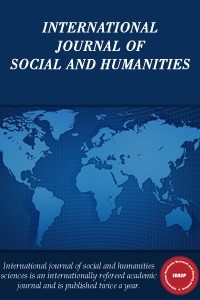MÜTAREKE DÖNEMİ İSTANBUL’UNDA BEYOĞLU’NUN ÇOK KÜLTÜRLÜ YAPISI VE FREJ APARTMANI
I. Dünya Savaşı; (1914-1918) devletlerarası kutuplaşma, Fransız ihtilalinin etkilediği milliyetçi hareketler, ham madde ve pazar arayışları neticesinde başlamış, Osmanlı imparatorluğunun da dâhil olmasıyla savaş uzun bir zamana ve geniş bir coğrafyaya yayılmıştı. Osmanlının da aralarında bulunduğu ittifak devletlerinin mağlubiyeti ile sonuçlanan savaş, siyasi alanda olduğu kadar sosyal alanda da yıkıcı sonuçlar doğurmuş, Osmanlı toplumu özellikle de Payitaht İstanbul bu süreçte derinden etkilenmiştir. İstanbul, kaybedilen topraklardan gelen göç dalgası, Batı Anadolu’nun Yunanlılar tarafından işgali ile oluşan göç ve Rusya’daki çarlık rejiminin yıkılışı ile başlayan Bolşevik devriminden kaçan Rus nüfusu için çekim merkezi ve yerleşim alanı haline gelmiştir.
Anahtar Kelimeler:
I. Dünya Savaşı, Beyoğlu, Pera, Apartman, Frej Apartmanı
BEYOGLU' S MULTI-CULTURAL STRUCTURE AND FREJ APARTMENT IN THE ISTANBUL OF THE ARMISTICE PERIOD
The World War I; (1914-1918) international polarization, nationalist movements influenced by the French revolution, and the search for raw materials and mar-kets began, with the inclusion of the Ottoman Empire, the war spread over a long period of time and over a wide geography. The war, which resulted in the defeat of alliance states, including the Ottoman Empire, had devastating conse-quences in the social as well as the political field, Ottoman society, especially capital city Istanbul, was deeply affected during this process. Istanbul, the wave of migration from the lost lands, members of the army returning to Istanbul dur-ing the armistice, it became the center of attraction and settlement for the Russian population who escaped from The October Revolution that started with the mi-gration of the greeks in western anatolia and the fall of the tsarist regime in Rus-sia. Although Istanbul was affected by this migration wave in its entirety, the center of concentration and attraction of the period was the Beyoglu region called Pera with its multicultural and multilingual structure. In this process; pub-lic order and health problems caused by the increasing population, era of scarci-ty, food and housing shortages have become evident, in addition to these nega-tivities, developments that affect the cultural and artistic life of the district also increase in social areas such as cinema and theatre. Beyoglu' s multicultural structure also affects architecture. The first examples of Ottoman architecture under the influence of the westernization of the 19th century and the form of buildings that bring together more than one family on the same foundations of a block of flats, due to the increasing population and changing lifestyles, the apartment building process starts in Beyoglu and Galata region by creating a new housing model for Istanbul. Frej Apartment is one of the buildings that re-flect this period and survived to the present day. Frej Apartment; it is located in Sishane Square and was built by Selim Hahna Frej. Designed in Art Nouveau and Baroque styles, the architect of the four-story apartment house is referred to as Kyrikiadis in documents. In this study, the multicultural structure of Beyoglu in Istanbul during the armistice period and the concept of apartment building which is the housing model of the period were examined and the processes of Frej Apartment, it is aimed to realize the period reading through the Frej Apart-ment by documenting the human stories of the period and the place that is expe-rienced in the interior and its reflections in the documents.
Keywords:
The World War I, Beyoglu, Pera, Apartment, Frej Apartment,
___
- Akıncı, T. (2018). Beyoğlu, (3. bs.). Remzi Kitabevi, İstanbul.
- Bakar, B. (2015). Esir Şehrin Misafirleri: Beyaz Ruslar, Tarihçi Kitabevi Yayınları, İstanbul.
- Baran, A. T. (2006). Mütareke Döneminde İstanbul’daki Rus Mültecilerin yaşamı, Atatürk Araştırma Merkezi Dergisi, XXII (64),122.
- Batur, A. (1994). Frej Apartmanı, Dünden Bugüne İstanbul Ansiklopedi-si, (c. 2, ss. 338-229). Kültür Bakanlığı ve Tarih Vakfı Ortak Yayını, İstanbul.
- Bilgin, İ. (1996). Tarihten Günümüze Anadolu’da Konut ve Yerleşme, Tarih Vakfı Yayınları, İstanbul.
- Bozdoğan, S. (2008). Modernizm ve Ulusun İnşası Erken Cumhuriyet Türkiyesi’ nde Mimari Kültür, Metis Yayınları, İstanbul.
- Criss, B. (2008). İşgal Altında İstanbul, (7. bs.). İletişim Yayınları, İstanbul. Dökmeci, V., Çıracı, H., (1990). Tarihsel Gelişim Sürecinde Beyoğlu, Türkiye Turing ve Otomobil Kurumu Yayınları, İstanbul.
- Eyice, S. (1984). Dirimtekin Feridun, Türkiye Diyanet Vakfı İslam Ansiklopedisi, (c.3, ss. 372). Türkiye Diyanet Vakfı Yayınları, İstanbul.
- Gülersoy, Ç. (1989). Frej Apartmanı, 7 ağustos 1989 da yayınlanan Cum-huriyet Gazetesi
- Gülersoy, Ç. (1990). Beyoğlu'nda Gezerken, (1. bs.). Çelik Gülersoy Vakfı İstanbul Kütüphanesi Yayınları, İstanbul.
- Onat, M. (1996). Frej Apartmanı Öyküsü, Ege Mimarlık Dergisi, (19) 21-37.
- Ortaylı, İ. (1979). Türkiye İdare Tarihi, TODAİE Yayını, Doğan Basıme-vi, Ankara.
- Sakaoğlu, N. (1994). Dünden Bugüne İstanbul Ansiklopedisi, (c. 1, ss. 281). Kültür Bakanlığı ve Tarih Vakfı Ortak Yayını, İstanbul.
- Sakaoğlu, N. (1994). Dünden Bugüne İstanbul Ansiklopedisi, (c. 2, ss. 212). Kültür Bakanlığı ve Tarih Vakfı Ortak Yayını, İstanbul.
- Sakaoğlu, N. (1994). Dünden Bugüne İstanbul Ansiklopedisi, (c. 5, ss. 203). Kültür Bakanlığı ve Tarih Vakfı Ortak Yayını, İstanbul.
- Toprak, Z. (1994). Mütareke Döneminde İstanbul, Dünden Bugüne İstan-bul Ansiklopedisi, (c. 6, ss. 19-23). Kültür Bakanlığı ve Tarih Vakfı Ortak Ya-yını, İstanbul.
- Topuzlu, C. (1982). 80 Yıllık Hatıralarım, İstanbul Üniversitesi Cerrahpa-şa Tıp Fakültesi Yayınlan, İstanbul.
- Üsdiken, B. (1994). Galvani'ler, Dünden Bugüne İstanbul Ansiklopedisi, (c. 2, ss. 412). Kültür Bakanlığı ve Tarih Vakfı Ortak Yayını, İstanbul.
- Yerasimos, S. (1992). Tanzimatın Kent Reformları Üzerine, Modernleşme Sürecinde Osmanlı Kentleri, editörler Paul Dumont ve François Georgeon; çevi-ren Ali Berktay, İstanbul: Tarih Vakfı Yurt Yayınları.
- http: //bellek.beyoglu.bel.tr
- https://www.google.com
- https://primo.getty.edu
- ISSN: 2602-3288
- Başlangıç: 2017
- Yayıncı: Tuncay AYDEMİR
Sayıdaki Diğer Makaleler
TÜRK EVİNDE SOKAĞA UZANAN İÇ MEKÂNLAR: ÇIKMALAR
KADIN TACİZLERİNE YÖNELİK BİR TUTUM ARAŞTIRMASI
YERE AİDİYETİN ÇEVREYİ ALGILAMA VE ANLAMLANDIRMAYA ETKİSİ ÜZERİNE HASKÖY BÖLGESİNDE BİR İNCELEME
MODERN MİMARLIKTA LE CORBUSIER ETKİSİ VE VİLLA SAVOYE MUTFAĞI
Charles MAZHAZHATE, T. MUDONDO
MÜTAREKE DÖNEMİ İSTANBUL’UNDA BEYOĞLU’NUN ÇOK KÜLTÜRLÜ YAPISI VE FREJ APARTMANI
